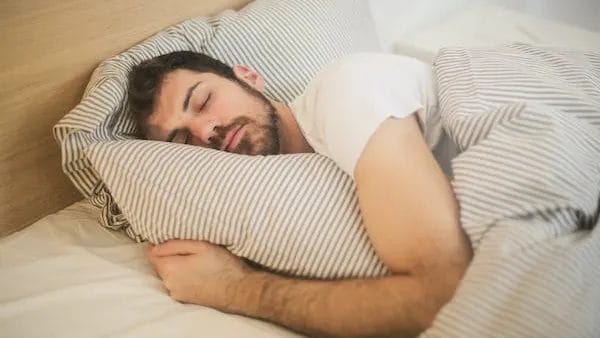The Dangers of Sleeping in the Wrong Position with Sleep Apnea
Sleep apnea is a common sleep disorder that affects millions of people worldwide. It is characterized by brief pauses in breathing during sleep, leading to disruptive and fragmented rest. While various factors contribute to sleep apnea, one often overlooked aspect is the position in which a person sleeps.
Understanding Sleep Apnea
Sleep apnea is a condition that occurs when the muscles in the throat fail to keep the airway open during sleep. This obstruction leads to repeated episodes of apnea, where breathing stops momentarily, and the brain is deprived of oxygen. These interruptions can happen multiple times throughout the night, causing a decrease in the quality of sleep and an array of health issues.
When it comes to understanding sleep apnea, it is important to delve deeper into the different types that exist. The most common type is obstructive sleep apnea (OSA), which happens when the throat muscles relax and block the airway. Central sleep apnea (CSA) is another type where the brain fails to send proper signals to the muscles that control breathing. Lastly, there is complex/mixed sleep apnea, which is a combination of both obstructive and central sleep apnea.
What is Sleep Apnea?
Sleep apnea is a sleep disorder characterized by pauses in breathing or instances of shallow or infrequent breathing during sleep. It can be classified into three types: obstructive sleep apnea (OSA), central sleep apnea (CSA), and complex/mixed sleep apnea.
Obstructive sleep apnea (OSA) is the most common type and occurs when the muscles in the back of the throat fail to keep the airway open. This leads to repeated episodes of partial or complete blockage, causing breathing to stop and start throughout the night. Central sleep apnea (CSA) is less common and happens when the brain fails to send proper signals to the muscles that control breathing. Complex/mixed sleep apnea is a combination of both obstructive and central sleep apnea, making it more challenging to diagnose and treat.
Common Symptoms of Sleep Apnea
Recognizing the symptoms of sleep apnea is crucial for early detection and effective treatment. Some common signs to watch out for include loud snoring, gasping for air during sleep, morning headaches, excessive daytime sleepiness, and difficulty concentrating.
Loud snoring is often one of the first signs that someone may have sleep apnea. The snoring can be disruptive not only to the person experiencing it but also to their bed partner. Gasping for air during sleep is another symptom that may indicate sleep apnea. This occurs when the body tries to compensate for the lack of oxygen by taking in a sudden deep breath. Morning headaches are also common among individuals with sleep apnea due to disrupted sleep patterns and lack of oxygen. Excessive daytime sleepiness is another symptom that can significantly impact a person’s quality of life. The constant interruptions in breathing during the night prevent them from getting restful sleep, leading to daytime fatigue. Difficulty concentrating is yet another symptom that can affect daily activities and productivity.
It is important to note that while these symptoms are common in sleep apnea, they can also be indicative of other health conditions. Therefore, it is crucial to consult with a healthcare professional for an accurate diagnosis and appropriate treatment.
The Connection Between Sleep Position and Sleep Apnea
The position in which a sleep apnea patient sleeps can have a significant impact on the severity of their symptoms. Changing sleep positions can help improve breathing and enhance sleep quality.
How Sleep Position Affects Breathing
Certain sleep positions can exacerbate the symptoms of sleep apnea by putting additional pressure on the airway. For example, sleeping on the back can cause the tongue and soft tissues in the throat to relax and block the air passage, leading to snoring and apnea episodes.
When a person with sleep apnea sleeps on their back, gravity pulls the tongue and other soft tissues backward, narrowing the airway. This narrowing can lead to increased resistance to airflow, making it difficult for the person to breathe properly during sleep. As a result, they may experience frequent pauses in breathing, known as apnea episodes, which can disrupt their sleep and affect their overall health.
On the other hand, sleeping on the side can help alleviate the symptoms of sleep apnea. Side sleeping can prevent the tongue and soft tissues from collapsing into the airway, allowing for a more open and unobstructed passage for air to flow. This can reduce snoring and decrease the frequency of apnea episodes, resulting in a better night’s sleep.
Worst Sleep Positions for Sleep Apnea
While sleeping on the back is generally considered the worst position for sleep apnea, some experts also advise against sleeping on the stomach as it can strain the neck and further restrict the airflow.
Sleeping on the stomach can cause the neck to twist and bend in an unnatural position, which can put a strain on the muscles and joints. This strain can lead to discomfort and potential breathing difficulties, especially for individuals with sleep apnea. Additionally, sleeping on the stomach can compress the chest and make it harder to breathe deeply, further exacerbating the symptoms of sleep apnea.
It is important for individuals with sleep apnea to find a sleep position that works best for them. While side sleeping is generally recommended, some people may find it more comfortable to sleep in a slightly elevated position using pillows or a bed wedge. This can help keep the airway open and reduce the likelihood of snoring and apnea episodes.
It is worth noting that changing sleep positions alone may not be enough to completely eliminate the symptoms of sleep apnea. It is important to consult with a healthcare professional for a comprehensive evaluation and to explore other treatment options, such as continuous positive airway pressure (CPAP) therapy or oral appliances, which can provide effective relief for sleep apnea.
The Risks of Incorrect Sleep Positions in Sleep Apnea Patients
Choosing the wrong sleep position can have severe consequences for sleep apnea patients, affecting their overall health and well-being.
Sleep apnea is a sleep disorder characterized by pauses in breathing or shallow breaths during sleep. It can lead to fragmented and poor-quality sleep, leaving individuals feeling exhausted and unrefreshed. While there are various treatment options available, including continuous positive airway pressure (CPAP) therapy and oral appliances, the importance of sleep position cannot be overlooked.
Health Complications from Improper Sleep Positions
Poor sleep positions can contribute to the progression of sleep apnea and increase the risk of developing other health conditions such as high blood pressure, cardiovascular disease, and diabetes. When individuals sleep in positions that obstruct their airways, it exacerbates the already compromised breathing patterns associated with sleep apnea. This can lead to further oxygen deprivation and strain on the cardiovascular system.
Research has shown that sleep apnea patients who sleep on their backs, also known as the supine position, are more likely to experience more frequent and severe apnea episodes compared to those who sleep on their sides. In the supine position, gravity pulls the tongue and soft tissues backward, blocking the airway and causing breathing difficulties.
Furthermore, improper sleep positions can contribute to the development of hypertension or high blood pressure. Sleep apnea already puts strain on the cardiovascular system, and when combined with the effects of poor sleep positions, the risk of hypertension increases significantly. The repetitive drops in oxygen levels and the subsequent surges in blood pressure during apnea episodes can have long-term detrimental effects on cardiovascular health.
Diabetes is another condition that can be influenced by sleep position in sleep apnea patients. Studies have shown that individuals with sleep apnea have a higher prevalence of insulin resistance, a precursor to diabetes. Sleeping in positions that worsen sleep apnea can further disrupt glucose metabolism and increase the risk of developing diabetes.
The Impact on Sleep Quality and Daytime Functioning
Sleeping in an unfavorable position not only disrupts the continuity of sleep but also reduces the overall quality. This can result in daytime fatigue, decreased cognitive function, mood disturbances, and decreased productivity. Sleep apnea patients who struggle to maintain a proper sleep position may experience more frequent awakenings throughout the night, leading to fragmented sleep and a lack of restorative rest.
Daytime fatigue is a common complaint among sleep apnea patients, and improper sleep positions can exacerbate this issue. When individuals are unable to maintain a position that keeps their airways open and unobstructed, the quality of their sleep suffers, leading to persistent tiredness and a lack of energy during the day. This can impact their ability to concentrate, make decisions, and perform daily tasks effectively.
In addition to fatigue, sleep apnea patients who sleep in positions that worsen their condition may experience mood disturbances. The chronic sleep deprivation associated with sleep apnea can contribute to irritability, mood swings, and even symptoms of depression. By adopting proper sleep positions, individuals can improve their sleep quality and potentially alleviate some of these mood-related symptoms.
Finally, the impact of improper sleep positions on productivity cannot be ignored. When individuals do not get enough restful sleep due to sleep apnea and unfavorable sleep positions, their ability to focus and perform at their best is compromised. This can have significant consequences in various aspects of life, including work, relationships, and overall quality of life.
In conclusion, choosing the right sleep position is crucial for sleep apnea patients. Proper sleep positions can help alleviate symptoms, improve sleep quality, and reduce the risk of developing other health complications. It is important for individuals with sleep apnea to consult with their healthcare providers to determine the most suitable sleep position and explore other treatment options to manage their condition effectively.
Strategies for Correcting Sleep Position
Fortunately, there are several strategies and tools available to help sleep apnea patients adopt better sleep positions and improve their overall sleep quality.
Tools and Devices to Aid in Proper Sleep Positioning
There are various products like positional pillows, wedge cushions, and body belts designed to encourage side sleeping, which can help keep the airway open and reduce the frequency of apnea episodes.
Role of Physical Therapy in Improving Sleep Position
Physical therapy can play a significant role in correcting sleep positions by addressing musculoskeletal imbalances and working on posture and breathing techniques.
Medical Treatments for Sleep Apnea
While correcting sleep positions is essential, medical interventions are sometimes necessary to manage sleep apnea effectively.
CPAP Therapy and Its Effectiveness
Continuous Positive Airway Pressure (CPAP) therapy is a common treatment for sleep apnea that involves wearing a mask that delivers a steady flow of air to keep the airway open during sleep.
Surgical Options for Sleep Apnea Treatment
In some cases, surgical interventions may be recommended for sleep apnea patients who are unable to tolerate or benefit from non-invasive treatments. Surgical procedures aim to widen the airway and reduce obstructions, leading to improved breathing and sleep quality.
In conclusion, sleeping in the wrong position can worsen the symptoms of sleep apnea and lead to various health complications. By understanding the connection between sleep position and sleep apnea, individuals can make informed choices and adopt strategies to improve their sleep quality and overall well-being. It is crucial to consult with a healthcare professional to determine the most appropriate treatment approach for managing sleep apnea effectively.




